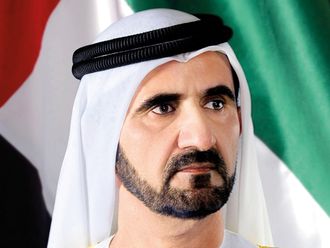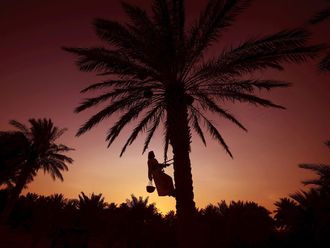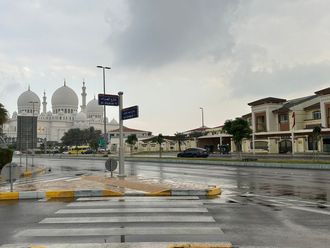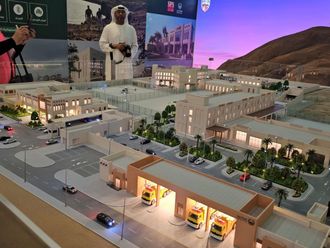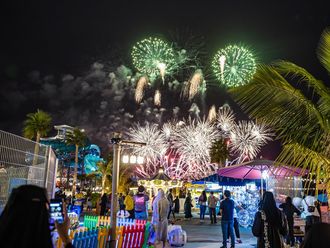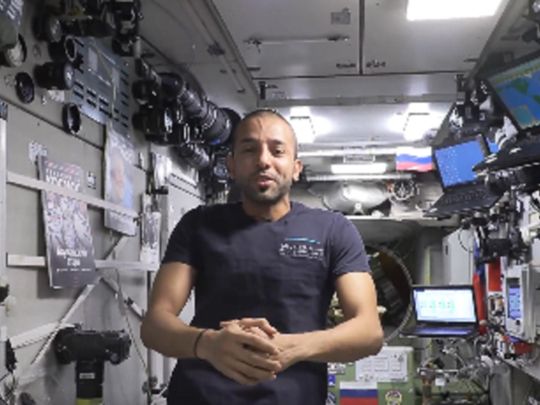
Dubai: How are astronauts weighed in the weightlessness of space? UAE astronaut Sultan Al Neyadi, who is on the longest Arab space mission on the International Space Station (ISS) has shared a video showing how it is done.
Taking to social media, Al Neyadi posted the video in which he described the procedure in Arabic.
In the post, he wrote: “On the International Space Station, weight is not measured like [how] we measure it on Earth. For this, we use a special device called BMMD (Body Mass Measurement Device).”
Al Neyadi explained that the device measures the mass of the body based on its oscillation. “But regardless of our actual weight, we feel like we’re floating because gravity is almost non-existent,” he pointed out.
Al Neyadi also posed a question to his followers asking them to share their weights in Ramadan with a big smiley emoji.
He can be seen using the BMMD device by doing push-up-like oscillating moves using the spring on it for about eight times. He holds the spring with both hands and pushes his chest against the spring, standing on the device all the while.
Weighing matters in weightlessness
A simple task on Earth, calculating body mass is much more challenging in a microgravity setting.
There are two types of body mass measurement devices on the ISS — the Russian body mass measuring device (BMMD), which uses spring oscillation physics, and NASA’s Space Linear Acceleration Mass Measurement Device (SLAMMD), which utilises Newton’s second law of motion (F=ma).
Both devices have produced body mass measurements that demonstrated that many crew members’ body mass had reduced throughout extended spaceflights in the past.
Many crew members on early space missions reportedly did not consume enough calories, which caused them to lose body mass while in orbit.
Inadequate diet and exercise has been linked to greater cardiovascular declines, increased oxidative damage, and increased muscle and bone loss in astronauts. Hence, it is important to monitor crew’s body mass to ensure they consume adequate energy intake and also get proper exercise to maintain their health.
Exercise in space
Al Neyadi had highlighted the importance of exercise in space in his previous posts. During his live interaction with the media on Wednesday night, he revealed that he has managed to maintain his weight and his health parameters had been constantly monitored by Dr Hanan Al Suwaidi of the Mohammed Bin Rashid Space Centre (MBRSC) in Dubai.
Al Neyadi also spoke to the media about the need for conveying space experiments and scientific aspects related to the mission in layman’s language which can be comprehended by people of all ages. He said that is what he was trying to achieve by posting some videos [such as this one] by incorporating some fun elements in science.
Undocking Dragon
Meanwhile, NASA said Al Neyadi is preparing to help with the undocking of SpaceX CRS-27 Cargo Dragon spacecraft from the ISS on Saturday.
He will be on duty along with NASA Flight Engineers Stephen Bowen and Woody Hoburg and Frank Rubio on Saturday morning, completing the stowage of critical research samples and loading of used station hardware inside Dragon.
Al Neyadi will then activate Dragon monitoring tools and software and close the vehicle’s hatch before the US cargo craft undocks at 11.05am EDT (7pm here) on Saturday.
The Dragon will parachute to a splashdown off the coast of Florida a few hours later for retrieval by SpaceX and NASA personnel. The completed research and discarded lab gear will then be sent to scientists and engineers around the world for analysis.
The Dragon had launched on SpaceX’s 27th contracted commercial resupply mission for NASA on March 14, from Launch Complex 39A at the agency’s Kennedy Space Centre in Florida. The spacecraft autonomously docked to the station’s Harmony module on March 16, with Hoburg monitoring operations from the station.
After spending about one month attached to the space station, the spacecraft will return to Earth with cargo and research. Dragon was packed with more than 6,200 pounds of science, equipment, and supplies including food for the astronauts.
Preparing for spacewalk
After Dragon completes its mission at the orbital lab, NASA said, the crew’s four astronauts and three cosmonauts will relax on Sunday before turning their attention to a series spacewalks set to begin on Tuesday, April 18.
Al Neyadi is scheduled to do the historic first spacewalk by an Arab, along with Bowen on April 28.


